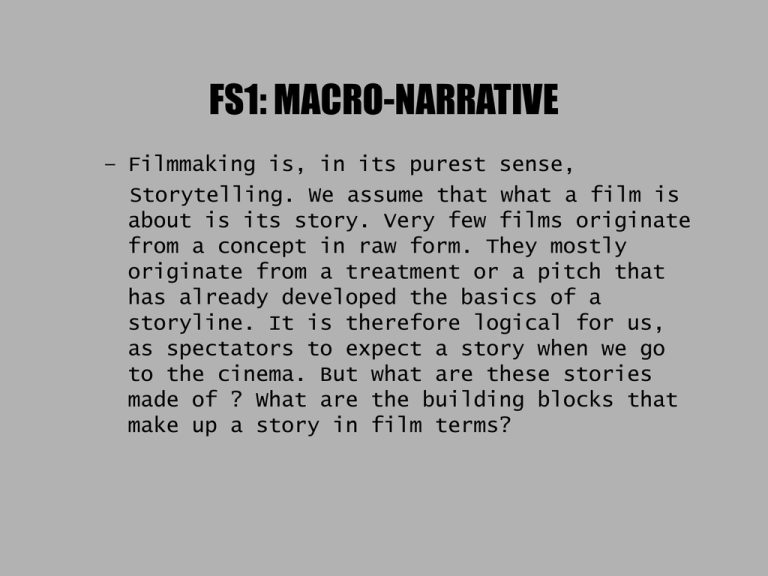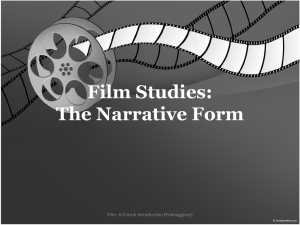FS1: MACRO-NARRATIVE
advertisement

FS1: MACRO-NARRATIVE – Filmmaking is, in its purest sense, Storytelling. We assume that what a film is about is its story. Very few films originate from a concept in raw form. They mostly originate from a treatment or a pitch that has already developed the basics of a storyline. It is therefore logical for us, as spectators to expect a story when we go to the cinema. But what are these stories made of ? What are the building blocks that make up a story in film terms? Story/Plot • The narrative of a film can be said to have two parts: the story and the plot. Though these may seem like the same thing, they represent the difference between what the elements of a narrative are and the ways in which we experience them. Story. • The story or “fabula” is the basic succession of events arranged in chronological order. This means that it is the outline of the events that occur within the timescale of the film, in the order that they occur. The fabula is a form of narrative but not necessarily the narrative in the sense that we experience it. The story is what may be written on the back of a Video box or DVD cover. This can be very different to the experience of watching a film in which the events do not occur chronologically, as in films like Pulp Fiction, Usual Suspects, 25th hour or Memento. When watching a film, as viewers we have become used to cause and effect sequence of events. In films that do not show events in the same order as the story, we try to reconstruct the fabula in our heads so as to be able to make sense of it. Plot. • The plot, also known as “Syuzhet” of a narrative is the sequence in which the events are shown to the spectator. This can often be very different to the story itself. The film “American beauty” begins with a shot of a young girl accepting an offer, made by the man filming her, to kill her father. In terms of the fabula, this event occurs two thirds of the way through the movie but by plotting it at the beginning of the movie, the filmmaker imbues the rest of the film with a sense of imminent doom, especially when we find out that the girl is the main character’s daughter. Syuzhet/Fabula • There can therefore be a distinction between the way a story is told (Syuzhet) and the events of the story itself (Fabula). When there is a distinction, our desire to reconstruct the Fabula from the information offered, by reorganising events into a cause and effect system, is part of what keeps us hooked. In most detective films, we follow the detective try to reconstruct the Fabula himself, and our often frustrated when we realise that he knows the sequence of events as they actually occurred before we do. Cause and Effect and Continuity editing • Though we will be looking it at more detail later, it is important to know that most mainstream filmmaking utilises a style of editing known as Continuity editing. Without getting into detail, it is best described as a form of assembling different shots in a way that makes the process invisible. Cuts between shots seem seamless and there is a logical progression from one scene to another. Quite often something will happen in one scene that will have an effect in another. Through years of watching films and TV, we have become accustomed to both the continuity style and the sense of logical progression. Even if the plot of a film is not chronological, therefore, there remains a sense of events of things moving forward towards a resolution. Narrative analysis. • Film specific narrative analysis is concerned with the extent to which the things that we see make sense. We instinctively assume that if a film shows something specific, like an object or a close-up of woman’s eye, it does so for a reason that serves the progression of the story. The viewer assumes that there will be a coherence to the chain of events. The pleasure of watching a film often derives from how we expect and anticipate this chain. In a horror film, viewers often shout at the screen; Don’t go in there! The viewers know that the character will probably meet a sticky end by doing so, yet enjoy the anticipation of seeing how, when and where she will be killed. The filmmakers draw on this anticipation to create suspense. Cause and Effect Chain • Event • Cause event effect=cause event effect=cause Tomorrow's theory of narrative • Despite the cause and effect chain, film narrative does operate within larger structures. According to Tzvetan Todorov, a narrative consists of an initial equilibrium that is disrupted in some way by a significant event. This causes disequilibrium. The only way to re-establish the balance is by taking action against that which caused the disruption. However, this reaction has the effect of changing the world for the protagonists so that the resolution always offers a new different equilibrium. Todorov’s theory of Narrative • Initial Equilibrium Disequilibrium Disruption Resolution Climax Propp and the role of characters. • Through a complex analysis of hundreds of Russian folk tales, the Russian theorist Vladimir Propp developed a structure for understanding consistencies across a broad range of narratives. He deduced two main factors: that there were common characters regardless of the type of story being told, and that there were common stages that characters must undergo. This was a fairly sophisticated mode of analysis that resulted in one easily graspable notion: that characters can be seen to drive a narrative. Propp’s character types • Though he cam up with more than 40, here are some of the main ones: • The Hero: The hero must overcome barriers to achieve resolution at the end. Having done so, he will be rewarded with the Princess and the villain will be defeated. • The Princess: The reward for the hero at the resolution. Usually has a Father figure who the hero must convince of his valour. • The Villain: A character who tries to prevent the hero form restoring the equilibrium. He may have been the cause for the disruption in the first place, and must be defeated by the hero. • The Donor: A character who will give the hero something, an object or knowledge, that will enable him to overcome the most difficult of barriers. • The Sidekick: The hero’s companion and ally who will accompany the hero on his journey. Character Drives • Though definitely useful, Proppean analysis has become a little outmoded today. The most important thing to understand is that the characters, mainly the hero, can be seen to be the agents of the logical progression of a narrative. They can be the cause for the effects. Todorov and Propp together Villain May cause the disruption. . Villain May create new barriers. princess Reward for the hero hero Barriers Hero must Initial Disruption overcome equilib barriers -rium. Disequilibrium Climax resoluti on Issues and Debates • Although these theories are essential for understanding the mechanics of film narrative, and can be applied to the majority of mainstream Hollywood cinema, there are problems with applying them to some more contemporary and original films. These theories can be applied to conventional and linear narratives. They do not consider the use of Subplot. A subplot is a secondary, less important narrative to be found within the main narrative but that works independently from it. They also cannot be applied to recent types of films that involve fragmented or disjointed plotting: Pulp Fiction and Memento are two good examples. These are called Alternative narratives. We will be looking at these in more detail later. Some points to consider. • I find it useful to consider narrative as a framing device. Film is a form of mediation, which always involves a process of selection and deselection. When one takes a picture with a camera, one chooses what to include and what to exclude. If a film is inherently a form of storytelling, then the way in which it reveals to the viewer a fictitious world is through the same process. A film neither has the time nor the ability to explore every aspect of the world that it creates; it only exposes that which is useful to both drive and develop the story. The narrative is therefore a frame itself that includes and excludes aspects of reality. The world outside the timescale and spatial scope of the film’s narrative is therefore as important to our understanding. What isn’t shown can be as important as what is. Pleasures. • Even though you wouldn’t have been able to explain it, these are all things you already knew. The act of watching thousands of film and hundreds of hours of TV, which you have all probably done has turned you all into experienced viewers. The pleasure of watching a film comes in following and anticipating chain and then having it resolved. Subconsciously, we all desire a reality that can tie itself up as neatly as it does in a film; where “happily ever after” could actually happen.







